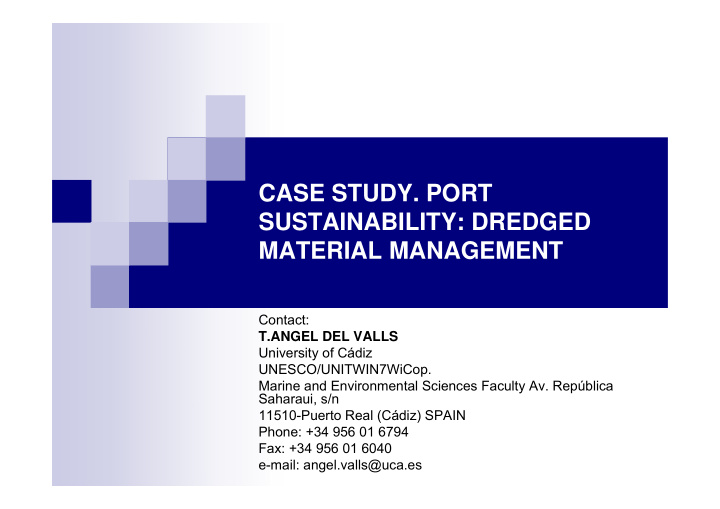



CASE STUDY. PORT SUSTAINABILITY: DREDGED MATERIAL MANAGEMENT Contact: T.ANGEL DEL VALLS University of Cádiz UNESCO/UNITWIN7WiCop. Marine and Environmental Sciences Faculty Av. República Saharaui, s/n 11510-Puerto Real (Cádiz) SPAIN Phone: +34 956 01 6794 Fax: +34 956 01 6040 e-mail: angel.valls@uca.es
Outline I General description of the areas � � Port of Cadiz; Huelva, Santos Problem description � Solutions / measures � Effects and lessons learnt �
Description of the areas � Cadiz bay
Description of the areas � Cadiz bay � Economy has been principally based on maritime commerce, fishing and ship construction as it hosts an important shipyard. � It is entry and exit door for merchant traffic from the European Union to the Magreb countries and also connects the Iberian penynsula with Canary Islands.
Description of the areas � Huelva
Description of the areas � Huelva � Important mining and metallurgical activities dating back three thousand years and based on pyrite (FeS2) and other sulphuric minerals. � Important industrial and fishing port with several dockyards and quays.
Description of the areas � Santos
Description of the areas � Santos � Biggest Brazilian industrial complex while major Latin American port. � Environmental importance: São Vicente Estuarine System surrounded by mangroves (43% of total mangrove area of São Paulo).
Problem description � Dredging is an essential activity for maritime navigation: � Deepening navigable waterways � Maintenance dredging � sand and mud deposited by water currents � estuarine areas –high deposition of riverine sediments.
Problem description Pose the sediments any risk to the environment? International framework of recommendations for dredged material characterisation and management. � London Convention � OSPAR � etc.
Solutions and measures � Step 1: Project planning, including the nature and the scope of the activities, the potential dredged material placement options and the regulatory requirements. � Step 2: Initial evaluation, where available data is examined. It may lead to the conclusion that no further pre-dredging evaluations are needed. If needed, one proceeds to Step 3. � Step 3: Physical, chemical and biological Step 3: Physical, chemical and biological � characterizations of dredged material. characterizations of dredged material. � Step 4: Interpretation of results of the data assembled and evaluated.
Solutions and measures � Traditional physico-chemical characterisation � Grain size/TOM � Metallic compounds –As, Cd, Cr, Cu, Hg, Ni, Pb, Zn � Organic compounds – Σ 7 PCBs � Not always required- Σ 12 PAHs � Comparison with limit values in use- � National Action Levels, i.e. Spain � Other empirically derived SQGs, i.e. TEL/PEL; ERL/ERM; etc.
Solutions and measures Action Level Level Approach Approach Action 8XAL2 AL1 AL2 No risk Evident risk ?
Solutions and measures � Management requirements in Spain according to dredged material characterisation Category Concentrations Aquatic disposal Type of license Requirements I C< AL1 Free aquatic Normal -Sedimentological disposal authorization studies and biological effects (physical/ mechanic). II AL1< C< AL2 Dumping under Special -Controlled dumping controlled authorization and justification. conditions -Impact hypothesis. -Environmental control management. -Corrective measures. III C> AL2 Dumping under Special -Contaminants sources adequate authorization study and source management control measures techniques -Isolation techniques and justification. -Impact hypothesis. -Environmental control program. -Corrective measures.
Solutions and measures � Ecotoxicological characterisation of sediment samples from Huelva, Cadiz and Santos Bioassay Exposure Duration Type of tests Endpoints route Adult amphipod Whole 10 days Acute Mortality sediment Informs on the potential toxic effects of sediments on benthic infauna.
Solutions and measures � Ecotoxicological characterisation of sediment samples from Huelva and Cadiz Bioassay Exposure route Duration Type of tests Endpoints Sea urchin Elutriates 48 hours Acute/chronic Arrested or abnormal embryos development Abnormal Informs on the Normal potential toxic effects of aqueous extracts on pelagic organisms during dredging/disposal.
Solutions and measures � Bioaccumulation potential of metals in commercial clams -Huelva and Cadiz- Bioassay Exposure route Duration Endpoint Juvenile Whole 28 days Tissue concentrations clams sediment of key compounds Informs on the potential bioaccumulation of compounds in commercial organisms/possible human health risks.
Solutions and measures � Dredged sediments from Port of Cadiz Sample Category Toxicity? Comments Management option CA1 I No Sand Beach nourishment CA2 III -Whole sediment Mud Confined disposal, isolation depending on Toxicity -Elutriates Identification Evaluations CA3 -Elutriates II -Bioaccumulation Mud Further assessment CA4 potential of Hg on environmental windows
Solutions and measures � Dredged sediments from Port of Huelva Sample Category Toxicity? Comments Management option H1 I -Whole sediment Mud Confined disposal, soft isolation H2 III -Whole sediment Mud Confined disposal, hard isolation -Elutriates H3 III -Whole sediment Mud/sand Separation (sand/mud) Confined disposal, hard isolation H4 I No Coarse Land reclamation Construction
Solutions and measures � Dredged sediments from Port of Santos Sample Category Toxicity? Comments Management option SSV1 I No Fines <10% Beneficial uses SSV2 II Yes Fines <10% Not suitable for sea disposal SSV3 II Yes Fines <10% Not suitable for sea disposal SSV4 I Yes Fines <10% Not suitable for sea disposal SSV5 I Yes Fines <10% Not suitable for sea disposal SSV6 I Yes Fines <10% Not suitable for sea disposal Further information on potential toxicity would allow to identify least detrimental management option.
Integrated approach for dredged material management Integrated approach for dredged material management (CHEMICAL+ECOTOXICOLOGICAL): (CHEMICAL+ECOTOXICOLOGICAL): - + Costs of characterisation: Environmental benefits: Environmental benefits: Only for not-completely characterised sediments - Risk-based decisions. Risk-based decisions. categoría II-. Economic benefits: Economic benefits: Management costs: Re-use of Re-use of For intermediate contaminated but not contaminated but not contaminated sediments toxic sediments toxic sediments causing toxicity.
Recommend
More recommend